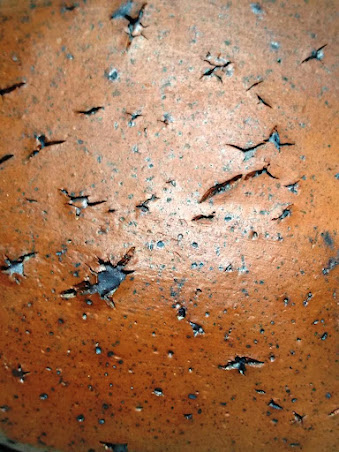221. KAWABUCHI Naoki 川淵直樹, 1946- , Nanban-style unglazed flask vase
Kawabuchi graduated from Wako University in 1971 and studied crafts history from renowned researcher and ceramicist Koyama Fujio. He trained in Akahada-ware in Nara and started the Warabe kiln in 1976, focusing mainly on Nanban yakishime (unglazed stoneware) and kohiki glaze (a dripped or swabbed white slip glaze). Kawabuchi is one of the authors of Building Your Own Kiln: Three Japanese Potters Give Advice and Instructions, published in 2003.
Dark clay, unglazed with blackened ash deposits and kiln colors ranging from dark red to dark brown. Weight: 2286 g (5.1 lb). Height: 17.1 cm (7 in). Width: mouth 2.8 cm (1-1/8 in); rim 6.8 cm (2-5/8 in); neck 4.4 cm (1-3/4 in); widest 23.3 cm (9-1/4 in); base 15.8 cm (6-1/4 in).
This sits on a circular base, a fairly even ring; the area within the base has been hollowed out in a concave arc with a roughly circular bulge in the middle. Above this the walls of the pot form a long convex arc to the neck, with the widest portion being 5.3 cm (2-1/8 in) above the base. There is a break at the shoulders ca. 12.5 cm (5 in) above the base. There is a line at this point where the walls slope inward more rapidly as they rise toward the neck, which is 14.4 cm (5-3/4 in) above the base. Above the neck the walls rise outward and upward at a sharp angle to the rim. The mouth of the piece is recessed below the rim. The four sides of the pot have been flattened somewhat, more so toward the shoulders, so that the piece is roughly squared off, but with rounded edges. The surface of the pot is blistered and cracked from the high-temperature (yakishime) firing. It is generally smooth in the parts that are not blistered.
The Nanban (“southern barbarian”) style uses no glaze and depends on kiln effects for the surface color and effects. The bottom of this has many rough, blackened ash deposits. There are two places on the walls that have ash deposits as well. One side of the pot is a dark brown; the remainder is a dark reddish brown.
This came with a wrapping cloth and a box inscribed in three lines: 南蛮 四方 (Nanban four-sided); 花X (can’t read the second character, but undoubtedly something that means “flower vase”); and 直 (the first character of the artist’s name), with his seal stamped in red.
This is a solid, substantial piece, giving the impression of almost sagging under its own weight. With rich colors and great surface effects from the firing.
Purchased from Treasures of Old Times, Bangkok, Thailand, June 2023.













No comments:
Post a Comment